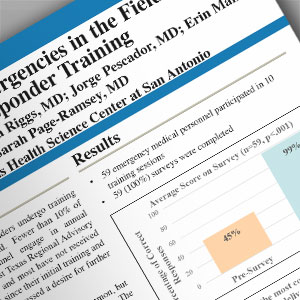ABSTRACTS
Obstetrical Emergencies in the Field: First Responder TrainingAuthor: Nicholas Stansbury BS | | UT Health San Antonio Long School of Medicine Associate Authors: Page-Ramsey Sarah, MD | Pescador, Jorge, BS | Riggs, Veronica, BS | Mankus, Erin, MD
Introduction In the area surrounding San Antonio, Texas, few first responders undergo refresher courses on emergency deliveries in the field. However, first responders continually ask for refresher courses due to lack of training in this area. While deliveries in the field are uncommon, they represent a vulnerable situation that demands rapid action and sound judgment. Objective Fourth-year medical students will teach first responders about emergency field deliveries with a lecture and hands-on session, educating and empowering participants to care for future patients in similar situations. Methods Students called 25 fire stations surrounding San Antonio to offer the course. Ten sessions were completed from October to December 2019. The course consisted of a 30-minute presentation covering: normal vaginal and breech deliveries, umbilical cord prolapse, shoulder dystocia and maternal hemorrhage. Afterward, a hands-on practice session was conducted wherein first responders practiced bimanual uterine massage, normal vaginal and breech deliveries using obstetric mannequins. Finally, the training concluded with practice questions revolving around clinical scenarios to solidify understanding. To assess the educational success, each participant took a pre-survey and post-survey. Results Fifty-nine first responders participated. The mean scores on the pre-test were 45% and 99% on the post-test (p< 0.001). Before the course, 55% of first responders felt confident about their ability to perform an emergency field delivery. After the course, 100% felt confident (p< 0.001). The mean percentage of correct responses improved from 45% to 99% (p<0.001). Conclusion The session yielded evidence of multifaceted improvement for participants. Participants showed a knowledge increase by more than doubling their success on the post-survey compared to the pre-survey. After the session, every participant felt confident about performing a delivery in the field while fewer than half felt confident before the session. The future direction of this project will be to develop a formal curriculum that can be widely distributed, free of charge, to all first responders and medical schools. This will allow educational partnerships to develop between medical schools and first responders throughout the country so this training can reach as many first responders as possible.
|

